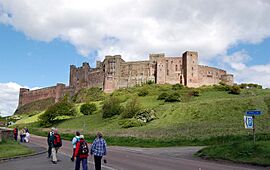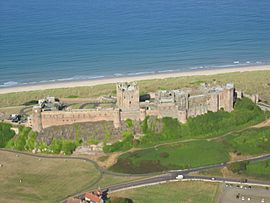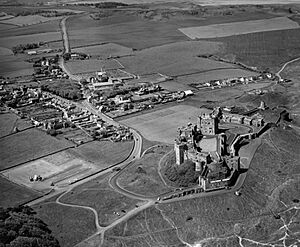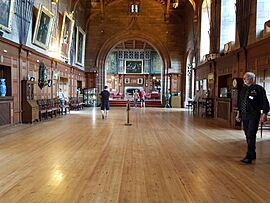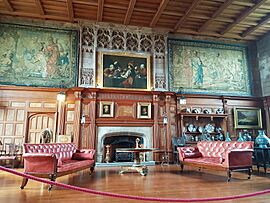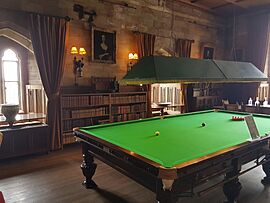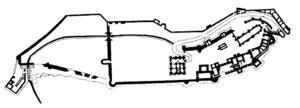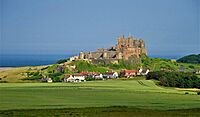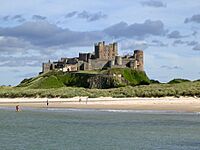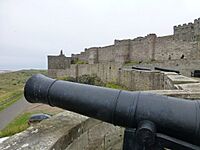Bamburgh Castle facts for kids
Quick facts for kids Bamburgh Castle |
|
|---|---|
| Bamburgh, Northumberland | |

Bamburgh Castle from the southwest
|
|
| Coordinates | 55°36′29″N 1°42′32″W / 55.608°N 1.709°W |
| Site information | |
| Owner | Armstrong family |
| Open to the public |
Yes |
|
Listed Building – Grade I
|
|
| Designated | 4 January 1952 |
| Reference no. | 1280155 |
| Site history | |
| Built | 11th century |
Bamburgh Castle is a famous castle located on the northeast coast of England. It stands proudly near the village of Bamburgh in Northumberland. This amazing building is so important that it's listed as a Grade I historic site.
Long, long ago, this spot was home to an ancient fort built by the Celtic Britons. It was called Din Guarie. Some historians believe it might have been the main city for the kingdom of Bernicia, starting around the year 420. In 547, an Anglo-Saxon king named Ida captured it. The fort changed hands a few times between the Britons and the Anglo-Saxons before the Anglo-Saxons took full control in 590.
Later, the Normans built a new castle right on this site. This Norman castle is the main part of the Bamburgh Castle we see today. In 1095, there was a rebellion, and the castle's owner supported it. After this, the castle became the property of the English king or queen.
Over time, the castle faced tough times and started to fall apart in the 1600s. But brave owners in the 1700s and 1800s worked hard to fix it up. Finally, a rich businessman named William Armstrong bought it in the late 1800s and finished its restoration. The Armstrong family still owns the castle today, and you can visit it!
Contents
History of Bamburgh Castle
Bamburgh Castle is built on a dark, rocky hill made of volcanic rock. This spot was first home to a fort of the native Celtic Britons. It was called Din Guarie. This fort might have been the capital of the Bernicia kingdom from about 420 AD. The first time the castle was mentioned in writing was in 547. In that year, the fort was captured by the Anglo-Saxon ruler Ida of Bernicia. It then became Ida's main base.
The Britons briefly took the castle back from Ida's son, Hussa, during a war in 590. But it was recaptured by the Anglo-Saxons later that same year. Around 600 AD, Hussa's successor, Æthelfrith, gave the castle to his wife, Bebba. This is where the early name Bebbanburh came from.
The Normans built a new castle on the site, which is the main part of the castle you see today. In 1095, King William II tried to capture it. The castle's owner, Robert de Mowbray, was supporting a rebellion. William II couldn't capture the castle easily. After Robert was caught, his wife kept defending the castle. She only gave up when the king threatened to harm her husband.
After this, Bamburgh Castle became the property of the English king. King Henry II likely built the main tower, called the keep, which was finished by 1164. Later, in 1191, King Richard I appointed Sir John Forster as the first Governor of Bamburgh Castle. This was a reward for his service in a big battle. In 1346, after the Scots were defeated in a battle, King David II was held prisoner at Bamburgh Castle.
During the civil wars at the end of King King John's rule, the castle was controlled by Philip of Oldcoates. In 1464, during the Wars of the Roses, the castle was under a long attack. It was attacked for nine months by Richard Neville, 16th Earl of Warwick, who was known as the "Kingmaker." He was fighting for the Yorkists, and they used many cannons during the attack.
Bamburgh Castle in Recent Times
The Forster family continued to be in charge of the castle for the king. In the mid-1500s, the king gave ownership of the castle to another Sir John Forster. The family owned it until Sir William Forster passed away in 1700. He was declared bankrupt after his death. His lands, including the castle, were sold in 1704 to pay off his debts. The buyer was Lord Crew, who was the Bishop of Durham.
Lord Crew put the castle in the care of a group of trustees. The leader of this group was Thomas Sharp. After Thomas Sharp died, his son, John Sharp, took over. John Sharp fixed up the castle's main tower and courtrooms. He also started a hospital there. In 1894, a wealthy businessman named William Armstrong bought the castle. He finished the big restoration work.
During World War II, small concrete shelters called pillboxes were built in the sand dunes. These were to protect the castle and the area from a German invasion. In 1944, a Royal Navy ship was even named HMS Bamborough Castle after the castle. The Armstrong family still owns the castle today.
After the war, in 1952, the castle was officially recognized as a Grade I Listed property. This means it's a very important historic building.
Castle Location and Nearby Sites
Bamburgh Castle is in a great spot on the coast. About 9 miles (14 km) to the south, you can find the old fortress of Dunstanburgh Castle. About 5 miles (8 km) to the north is Lindisfarne Castle on Holy Island. If you travel inland about 16 miles (26 km) south, you'll reach Alnwick Castle, which is the home of the Duke of Northumberland.
Wildlife Around the Castle
The air quality near Bamburgh Castle is very good because there aren't many factories nearby. The area is also home to interesting wildlife. You can find breeding colonies of Arctic and common terns on the nearby Farne Islands. On Staple Island, there are also Atlantic puffins, European shags, and razorbills.
Archaeological Discoveries at Bamburgh
Archaeological digs started at Bamburgh in the 1960s. A researcher named Brian Hope-Taylor found a gold plaque called the Bamburgh Beast and a special sword known as the Bamburgh Sword. Since 1996, the Bamburgh Research Project has been studying the castle's history and the surrounding area. They have focused on the fortress site and an old burial ground called the Bowl Hole. This burial ground is in the sand dunes south of the castle. People first found evidence of it during a storm in 1817.
Between 1998 and 2007, during excavations at the Bowl Hole, the remains of 120 people from the 600s and 700s were found. This research project was led by Professor Charlotte Roberts from Durham University. They discovered remains of people who came from places like Ireland, Scotland, Scandinavia, the Mediterranean, and North Africa.
In 2016, these remains were moved to the crypt of St Aidan's Church, Bamburgh. Visitors can see the crypt through a small gate.
Armstrong and Aviation Artefacts Museum
Inside the castle's old laundry rooms, there is a museum called the Armstrong and Aviation Artefacts Museum. It has exhibits about the Victorian businessman William Armstrong and his company, Armstrong Whitworth. This company made many things, including engines, weapons, and aircraft parts. The museum shows items from both World Wars.
Gallery
See also
 In Spanish: Castillo de Bamburgh para niños
In Spanish: Castillo de Bamburgh para niños



